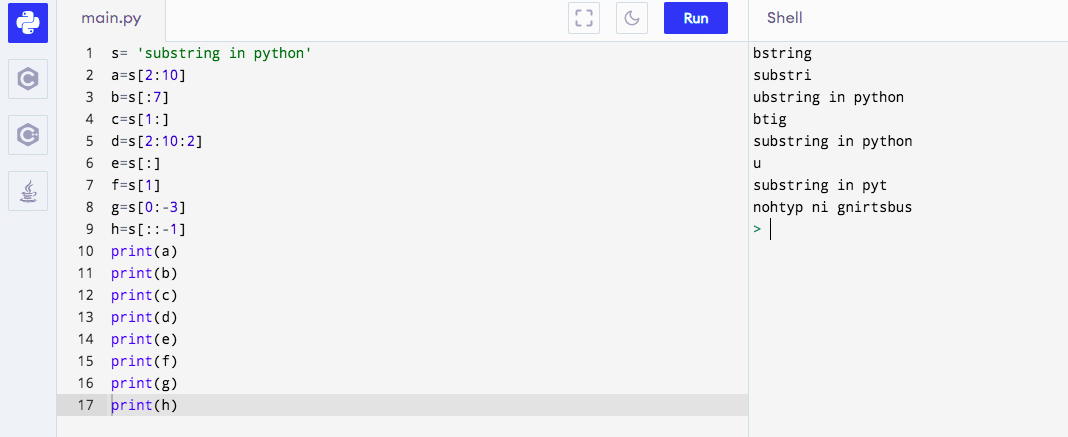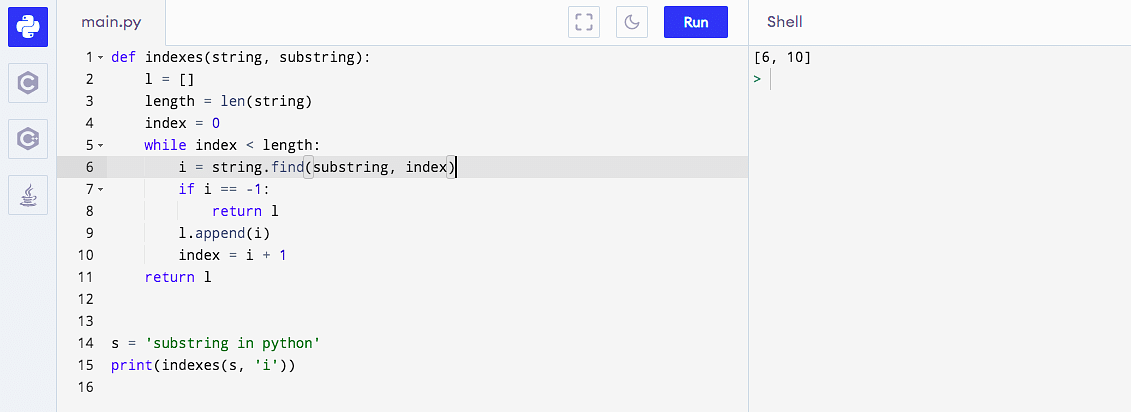A chain of Unicode persona(s) is named a string. It accommodates a chain of characters or a sequence that can include particular characters and alphanumeric. This text makes a speciality of the concept that of the substring in python and the way it works.
What Is a Substring in Python?
A part of a string is referred to as a substring. There are more than one strategies for making a substring in python and checking if a substring is found in a string, index of a substring, and extra. Allow us to take a look at quite a lot of operations associated with substrings.
How one can Create a Substring
A substring can also be created the use of some ways. Some of the fashionable techniques is string cutting.
To create a listing of substrings according to a selected delimiter found in a string, we use the cut up() serve as.
A substring in python can also be generated via cutting as follows:
string[begin: end: step]
the place,
start: is the beginning index of the substring. The substring contains this component. If start isn’t discussed whilst cutting, it’s assumed as 0.
Step: is the nature that needs to be incorporated after the present persona. The default price of the step is one and is thought as one if now not discussed.
Finish: is the finishing index of the substring. This component is excluded within the substring. It’s assumed to be the similar because the string’s period if the worth isn’t specified or the given price exceeds the string period.
The syntax for cutting a string:
1. string[begin: end]: substring contains characters from begin to end-1. Instance:
s= ‘substring in python.’
s[2:10]
Output: ‘bstring’
2. string[: end]: substring contains characters from begin to end-1. Instance for cutting with out start index:
s= ‘ substring in python.’
s[:7]
Output: ‘substri
3. string[begin:]: substring contains characters from the start index to the top of the string. Instance for cutting forever index:
s= ‘substring in python.’
s[1:]
Output: ‘ubstring in python’
4. string[begin:end: step]: substring contains characters from begin to end-1 excusing each step persona. Instance for cutting with step-index:
s= ‘substring in python’
s[2:10:2]
Output: ‘btig’
5. s[:]- substring contains all of the string. Instance for cutting with out start or finish index :
s= ‘substring in python’
s[:]
Output: ‘usbstring in python’
6. s[index]: substring features a unmarried persona. Instance for purchasing persona at a given index:
s= ‘substring in python’
s[1]
Output : ‘u’
7. Unfavorable slicing- Use a destructive index for purchasing a substring. Instance:
s= ‘ substring in python ‘
s[0:-3]
Output: ‘substring in pyt’
8. Reversing a string- Reducing can be utilized to go back the opposite of string the use of a destructive step. Instance:
s= ‘substring in python’
s[::-1]
Output: ‘nohtyp ni gnirtsbus’
The output of all of the above templates:

Code to show the advent of substring in python:
s= ‘ substring in python ‘
# create a substring the use of cutting
a = s[11:]
print(a)
# Create record of substrings the use of cut up serve as
b = s.cut up()
print(b)
Output:

How one can Test if the Substring Is Discovered
in finding() serve as or the in operator is used to test if a substring is provide within the given string or now not.
We will be able to use in operator or find() function to test if the string’s substring is provide within the string. Here’s an instance
s= ‘ substring in python ‘
if ‘python’ in s:
print(‘Substring discovered’)
if s.in finding(‘all’) != -1:
print(‘Substring discovered’)
else:
print(‘Substring now not discovered’)
Output:

To search out the selection of occurrences of a given substring within the enter string, use the depend() serve as as follows:
s = ‘That is the depend’
print(‘Substring depend =’, s.depend(‘i’))
Output:

To search out all indexes of substring in python, there’s no built in serve as. However we will outline one the use of in finding() serve as to get the record of all indexes for a substring. Right here’s how:
def indexes(string, substring):
l = []
period = len(string)
index = 0
whilst index < period:
i = string.in finding(substring, index)
if i == -1:
go back l
l.append(i)
index = i + 1
go back l
s = ‘substring in python’
print(indexes(s, ‘i’))
Output:

How one can Get the Substring From a Given String The use of Record Reducing
After we are given a string, we will get the substring in python the use of record cutting. Listed here are a couple of examples:
1. Code to create a substring in python from a string
# Initialise the string
string = ‘substring in python’
print (“Preliminary string: “, string)
# developing substring from starting
# outline upto what index substring is wanted
get started = string[:2]
finish = string[3:]
#consequence
print (“Resultant substring from get started:”, get started)
print (“Resultant substring from finish:”, finish)
Output:

2. Create a substring via taking characters from a specific hole (step)
# Initialise string
string = ‘substring in python’
print (“Preliminary String: “, string)
# create substring via taking component after sure place hole and outline period upto which substring is needed
alt = string[::2]
hole = string[::3]
# consequence
print (“Resultant substring from get started:”, alt)
print (“Resultant substring from finish:”, hole)
Output:

3. Create a substring whilst taking into account string from the center with some step hole between characters
# Initialise string
string = ‘substring in python’
print (“Preliminary string: “, string)
# create substring via taking component after sure step hole in an outlined period
astring = string[2:11:2]
# consequence
print (“Resultant substring:”, astring)
Output:

We have now reached the top of the object on ‘substring in python’. The entire examples given above shape an concept of ways cutting works and the way it is helping create substrings of quite a lot of sorts in python additionally take a look at our subsequent educational on Queue in Python And if you want to grasp python out and in, you’ll sign up in our Python Coaching. Continue learning!
supply: www.simplilearn.com












